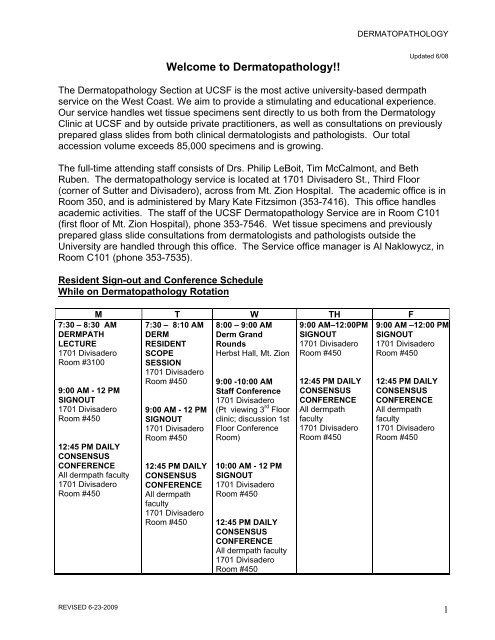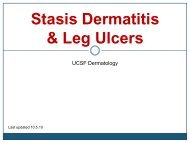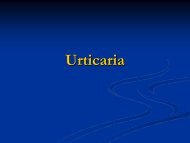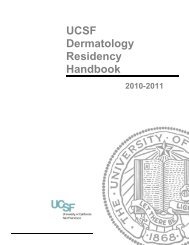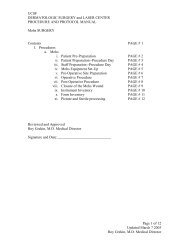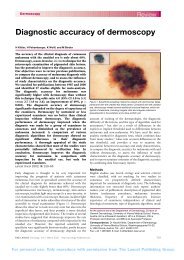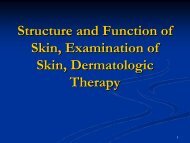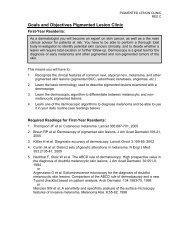Welcome to Dermatopathology - Dermatology
Welcome to Dermatopathology - Dermatology
Welcome to Dermatopathology - Dermatology
You also want an ePaper? Increase the reach of your titles
YUMPU automatically turns print PDFs into web optimized ePapers that Google loves.
<strong>Welcome</strong> <strong>to</strong> Derma<strong>to</strong>pathology!!<br />
DERMATOPATHOLOGY<br />
Updated 6/08<br />
The Derma<strong>to</strong>pathology Section at UCSF is the most active university-based dermpath<br />
service on the West Coast. We aim <strong>to</strong> provide a stimulating and educational experience.<br />
Our service handles wet tissue specimens sent directly <strong>to</strong> us both from the Derma<strong>to</strong>logy<br />
Clinic at UCSF and by outside private practitioners, as well as consultations on previously<br />
prepared glass slides from both clinical derma<strong>to</strong>logists and pathologists. Our <strong>to</strong>tal<br />
accession volume exceeds 85,000 specimens and is growing.<br />
The full-time attending staff consists of Drs. Philip LeBoit, Tim McCalmont, and Beth<br />
Ruben. The derma<strong>to</strong>pathology service is located at 1701 Divisadero St., Third Floor<br />
(corner of Sutter and Divisadero), across from Mt. Zion Hospital. The academic office is in<br />
Room 350, and is administered by Mary Kate Fitzsimon (353-7416). This office handles<br />
academic activities. The staff of the UCSF Derma<strong>to</strong>pathology Service are in Room C101<br />
(first floor of Mt. Zion Hospital), phone 353-7546. Wet tissue specimens and previously<br />
prepared glass slide consultations from derma<strong>to</strong>logists and pathologists outside the<br />
University are handled through this office. The Service office manager is Al Naklowycz, in<br />
Room C101 (phone 353-7535).<br />
Resident Sign-out and Conference Schedule<br />
While on Derma<strong>to</strong>pathology Rotation<br />
7:30 – 8:30 AM<br />
DERMPATH<br />
LECTURE<br />
1701 Divisadero<br />
Room #3100<br />
9:00 AM - 12 PM<br />
SIGNOUT<br />
1701 Divisadero<br />
Room #450<br />
12:45 PM DAILY<br />
CONSENSUS<br />
CONFERENCE<br />
All dermpath faculty<br />
1701 Divisadero<br />
Room #450<br />
M T W TH F<br />
7:30 – 8:10 AM<br />
DERM<br />
RESIDENT<br />
SCOPE<br />
SESSION<br />
1701 Divisadero<br />
Room #450<br />
9:00 AM - 12 PM<br />
SIGNOUT<br />
1701 Divisadero<br />
Room #450<br />
12:45 PM DAILY<br />
CONSENSUS<br />
CONFERENCE<br />
All dermpath<br />
faculty<br />
1701 Divisadero<br />
Room #450<br />
8:00 – 9:00 AM<br />
Derm Grand<br />
Rounds<br />
Herbst Hall, Mt. Zion<br />
9:00 -10:00 AM<br />
Staff Conference<br />
1701 Divisadero<br />
(Pt viewing 3 rd Floor<br />
clinic; discussion 1st<br />
Floor Conference<br />
Room)<br />
10:00 AM - 12 PM<br />
SIGNOUT<br />
1701 Divisadero<br />
Room #450<br />
12:45 PM DAILY<br />
CONSENSUS<br />
CONFERENCE<br />
All dermpath faculty<br />
1701 Divisadero<br />
Room #450<br />
9:00 AM–12:00PM<br />
SIGNOUT<br />
1701 Divisadero<br />
Room #450<br />
12:45 PM DAILY<br />
CONSENSUS<br />
CONFERENCE<br />
All dermpath<br />
faculty<br />
1701 Divisadero<br />
Room #450<br />
9:00 AM –12:00 PM<br />
SIGNOUT<br />
1701 Divisadero<br />
Room #450<br />
12:45 PM DAILY<br />
CONSENSUS<br />
CONFERENCE<br />
All dermpath<br />
faculty<br />
1701 Divisadero<br />
Room #450<br />
REVISED 6-23-2009 1
DERMATOPATHOLOGY<br />
Morning signout will be conducted by the dermpath faculty on consultation material. As<br />
the pace of signout can be rapid, we encourage you <strong>to</strong> ask <strong>to</strong> see a slide we have<br />
reviewed on your own if you need more time <strong>to</strong> study it. We will also tell the UCSF<br />
derma<strong>to</strong>logy resident on the rotation how <strong>to</strong> arrange <strong>to</strong> spend a 1-2 hour session with our<br />
grossing supervisor, David Marrs, <strong>to</strong> gain a better understanding of how tissue is handled<br />
after receipt. The derma<strong>to</strong>logy resident will also spend a session with Dr. Kari Connolly in<br />
the immunofluorescence labora<strong>to</strong>ry. These are required.<br />
The Consensus Conference meets daily promptly at 12:45 PM, during which time the<br />
dermpath faculty bring cases for interest or consultation.<br />
Derma<strong>to</strong>logy Grand Rounds (a 1-hour lecture on an important <strong>to</strong>pic regarding clinical<br />
derma<strong>to</strong>logy or derma<strong>to</strong>pathology) is from 8-9 on most Wednesday mornings. Please<br />
check with the online schedule of the Derma<strong>to</strong>logy Department for the month or months<br />
you are on rotation. Derma<strong>to</strong>logy "Staff Conference" (from 9-10 on Wednesday mornings)<br />
is one of the opportunities <strong>to</strong> see patients during the rotation. The derma<strong>to</strong>pathologic<br />
findings are often presented as well. Attendance is expected. The derma<strong>to</strong>logy and<br />
pathology departments also have other conferences which may be of interest – ask for the<br />
month’s schedule.<br />
The afternoons on the rotation have been reserved for your independent study, while<br />
teaching signout may continue in<strong>to</strong> the afternoon on occasion. Many resources are<br />
available with respect <strong>to</strong> how <strong>to</strong> make the most of this time (see below).<br />
Derma<strong>to</strong>pathology Etiquette<br />
The learning environment around the microscope may be different than you have<br />
encountered previously. So we offer a few words on that account:<br />
1. Please be on time <strong>to</strong> teaching signout (which may vary slightly in its start time,<br />
but will not start before 9 AM), teaching sessions and faculty consensus<br />
conference, <strong>to</strong> avoid disruption.<br />
2. While it is fine <strong>to</strong> bring reading material <strong>to</strong> refer <strong>to</strong> during the session, please<br />
keep conversation <strong>to</strong> a minimum, especially while the faculty is dictating.<br />
Remember, it is a working signout, while also a teaching session. There is also<br />
important learning information being transmitted about the material during<br />
dictation, so listen in.<br />
3. Unless there is an urgent need, please keep your cell phones and pagers in<br />
silent mode.<br />
4. It is alright <strong>to</strong> bring a beverage in<strong>to</strong> the scope room, but no food please.<br />
REVISED 6-23-2009 2
Perspective on the UCSF Derma<strong>to</strong>pathology Service<br />
DERMATOPATHOLOGY<br />
The UCSF Derma<strong>to</strong>pathology Service has evolved in<strong>to</strong> the only vehicle at the University<br />
for the instruction of skin pathology <strong>to</strong> both pathologists and derma<strong>to</strong>logists. Without the<br />
service, much of the breadth and volume of the dermpath experience we provide would be<br />
lost. Residents on the rotation have an active role in the service, and interpretation of<br />
specimens by the attending is done in the presence of the residents and fellows. Keep in<br />
mind that our service attempts <strong>to</strong> meet the financial challenges of managed care, while<br />
simultaneously providing "cutting edge" diagnostic work with maximal information provided<br />
on each specimen.<br />
Case Numbering Systems and Retrieval of Results<br />
Cases prior <strong>to</strong> 1995 were assigned <strong>to</strong> one of multiple numbering systems, depending upon<br />
how the case arrived at the service. All cases after 1995 are assigned a unique accession<br />
number consisting of the year, then a hyphen, then an additional number (for example, the<br />
first case accessioned in 1998 was “98-00001”; the second case was “98-00002.”) Each<br />
case is also assigned <strong>to</strong> a lettering system, depending upon how the case entered the<br />
department and some other fac<strong>to</strong>rs. The lettering system is generally used for billing and<br />
statistical purposes and can be ignored for the most part. Some letters you may see are<br />
DT – wet tissue specimens originating from outside the hospital<br />
DS – slide consultations<br />
DH – all hospital cases, whether inpatient or outpatient<br />
DI -- immunofluorescence cases<br />
DR – research cases<br />
DN – no charge cases<br />
Different departments of the hospital use different report retrieval systems which are not<br />
completely linked. Almost all reports after 1990 can be retrieved through the Intellipath<br />
system, which is found only on terminals within the derma<strong>to</strong>pathology offices. The<br />
personnel in the Service office at 353-7546 will be happy <strong>to</strong> retrieve these reports for you.<br />
Reports prior <strong>to</strong> 1990 can be obtained through Mary Kate Fitzsimon in the Academic office.<br />
Some cases are logged in<strong>to</strong> the Co-path system found in the pathology department, but<br />
the diagnoses and reports for those cases are usually NOT entered in<strong>to</strong> this system and<br />
the cases usually appear as “incomplete” even after they are signed out. A patient who<br />
has a UC identification number which is known <strong>to</strong> the derma<strong>to</strong>pathology service (in other<br />
words, the patient was seen within the medical center) should have a complete report<br />
available within the STOR system.<br />
REVISED 6-23-2009 3
Available Educational Materials in Derma<strong>to</strong>pathology<br />
DERMATOPATHOLOGY<br />
The standard texts are Weedon’s Skin Pathology*, Lever's His<strong>to</strong>pathology of the Skin, and<br />
McKee’s Pathology of the Skin. Chapters from Maize’s Cutaneous Pathology are<br />
generally the basis for the Derma<strong>to</strong>pathology lectures on Monday mornings. These are all<br />
available in our office, as is the most comprehensive text on inflamma<strong>to</strong>ry skin disease,<br />
Ackerman's His<strong>to</strong>pathology of Inflamma<strong>to</strong>ry Skin Disease: A Method by Pattern Analysis.<br />
There are also a number of monographs available on specific <strong>to</strong>pics in Derma<strong>to</strong>pathology,<br />
such as adnexal neoplasms, melanoma, and lymphomas. The best way <strong>to</strong> develop skill in<br />
the field is <strong>to</strong> read about cases you encounter and <strong>to</strong> master basic derma<strong>to</strong>pathologic<br />
concepts. Please do not remove these resources from the Department. Depending of<br />
course on your background, during the rotation, you should work <strong>to</strong>ward mastery of the<br />
following introduc<strong>to</strong>ry <strong>to</strong>pics:<br />
1. pattern analysis of basal cell carcinoma<br />
2. types of melanocytic nevi and eponymic naming of nevi<br />
3. architectural criteria for recognition of melanoma and distinction of melanoma from<br />
melanocytic nevi<br />
4. architectural criteria for mycosis fungoides<br />
5. recognition of the basic patterns of inflamma<strong>to</strong>ry skin disease, with a brief<br />
differential diagnosis for each pattern.<br />
*UCSF residents may check out a copy of Weedon’s during their rotation, from our<br />
academic office. All first year UCSF derma<strong>to</strong>logy residents will be provided with their own<br />
copy compliments of the Derma<strong>to</strong>pathology faculty.<br />
In addition, there is a list of dermpath diagnoses that each UCSF derma<strong>to</strong>logy resident<br />
should master according <strong>to</strong> their year of training, which can be found in the derma<strong>to</strong>logy<br />
resident glass slide collection. Please make sure that those have been studied during your<br />
time on the rotation.<br />
An invaluable correlate for pathology residents rotating through derma<strong>to</strong>pathology is a<br />
basic knowledge of clinical derma<strong>to</strong>logy. The paperback by Lookingbill and Marks, Clinical<br />
Derma<strong>to</strong>logy, is the one used as an introduction for residents and medical students<br />
rotating through derma<strong>to</strong>logy. We highly recommend that you read the book in its entirety<br />
at the start of your rotation. The brief paperback, Derma<strong>to</strong>pathology by Burgdorf<br />
(Springer-Verlag, 1984) can also be read in its entirety and provides a valuable overview.<br />
We have lost our copy of this book, but you may be able <strong>to</strong> find one elsewhere.<br />
There are glass slide collections available in the scope room – we would encourage you <strong>to</strong><br />
use them. Looking at unknown cases and then reading about the entities you encounter is<br />
one of the best ways <strong>to</strong> gain skill in any pathology discipline, including derma<strong>to</strong>pathology.<br />
The importance of reading during the rotation cannot be overstated.<br />
Another informative study <strong>to</strong>ol is the website http://www.mdlive.net/ Under Program<br />
Series Available, there is the Derma<strong>to</strong>pathology Master Series covering many <strong>to</strong>pics on<br />
derma<strong>to</strong>pathology. Under “Archived Lectures”, find Derma<strong>to</strong>pathology Master Classes for<br />
the available programs. Sign the Guest Book (no password required) <strong>to</strong> access the<br />
lectures.<br />
REVISED 6-23-2009 4
Rules regarding study set slides<br />
DERMATOPATHOLOGY<br />
1. All boxes should be maintained in consecutive order within their present<br />
location.<br />
2. Only one box will be removed for study at a time.<br />
3. Slides should be replaced in<strong>to</strong> the proper slot in the box. Please do not leave<br />
slides out on surfaces.<br />
4. When study of the cases from one box has been completed, this box should be<br />
replaced and then the new box can be removed for study.<br />
5. The slide boxes should never be left at your microscope but should be replaced<br />
in the filing location as soon as you have finished your study. This means that<br />
all boxes should be replaced over lunch and overnight.<br />
6. Please notify Mary Kate regarding any missing slides (include the box number<br />
and the case number). They will consult with us <strong>to</strong> determine if replacement is in<br />
order.<br />
7. Please notify Mary Kate if you believe there is a case with an incorrect diagnosis.<br />
They will consult with us <strong>to</strong> see if a correction is necessary.<br />
8. Slide boxes may not be removed from the Department for any reason.<br />
Clinicopathologic correlation<br />
We are occasionally asked as a group <strong>to</strong> see patients in the derma<strong>to</strong>logy clinic for<br />
clinicopathologic correlation. As such, please dress professionally (no sweats, scrubs,<br />
jeans or tennis shoes). Be considerate of the patient’s privacy and reserve any<br />
commentary <strong>to</strong> a time when outside the examination room.<br />
Immunofluorescence and Specialty Clinics in the UCSF Derma<strong>to</strong>logy Department<br />
Since 1995, immunofluorescence diagnostic testing has been available through our<br />
service by Dr. M. Kari Connolly. Talk <strong>to</strong> us for additional information regarding Dr.<br />
Connolly’s signout schedule. Signout sessions will be arranged for the derma<strong>to</strong>logy<br />
resident on the rotation. There are two specialty clinics that may be of interest. The<br />
Melanoma Clinic and Cutaneous Lymphoma Clinic, headed by Dr. Mohammed Kashani-<br />
Sabet, provide an opportunity <strong>to</strong> see patients with disorders in which clinicopathologic<br />
correlation is extremely important. Please ask us <strong>to</strong> make arrangements should you wish<br />
<strong>to</strong> observe either clinic.<br />
Research Opportunities<br />
For interested residents and students, a variety of writing and investigative opportunities<br />
are available. Both case reports and projects can be pursued that may culminate in<br />
publication. If you wish <strong>to</strong> consider a research project, see us for ideas and details.<br />
REVISED 6-23-2009 5
Goals and Objectives of Derma<strong>to</strong>pathology<br />
First-Year Residents<br />
1. Learn a general approach <strong>to</strong> his<strong>to</strong>pathologic diagnosis.<br />
DERMATOPATHOLOGY<br />
2. Be able <strong>to</strong> identify common cutaneous neoplasms (i.e. seborrheic kera<strong>to</strong>sis,<br />
malanocytic nevus, etc.) and common inflamma<strong>to</strong>ry patterns (i.e. spongiotic dermatitis,<br />
interface dermatitis, etc.) with reasonable reliability.<br />
3. Understand basic principles of gross pathology: how specimens are “cut in” and how<br />
that affects the practice of pathology.<br />
4. Understand fundamentals of clinicopathologic correlation.<br />
5. Be able <strong>to</strong> rationally explain the fundamental nature of disease processes (i.e. cysts,<br />
malformations, hamar<strong>to</strong>mas, hyperplasias, benign and malignant neoplasms, etc).<br />
6. For UC trainees, review the UCSF derma<strong>to</strong>logy resident slide set of diagnoses based<br />
on your year of training, and read on those as well.<br />
Readings<br />
Skin Pathology, David Weedon; contribu<strong>to</strong>r, Geoffrey Strut<strong>to</strong>n. 2nd ed. London; New York:<br />
Churchill Livings<strong>to</strong>ne, 2002<br />
Also see the Differential Diagnosis I through IV by A. Bernard Ackerman, available in our<br />
library.<br />
REVISED 6-23-2009 6
Goals and Objectives of Derma<strong>to</strong>pathology<br />
Second-Year Residents<br />
1. Learn criteria for specific diseases and be able <strong>to</strong> express them lucidly.<br />
DERMATOPATHOLOGY<br />
2. Develop differential diagnoses for commonly encountered his<strong>to</strong>pathologic patterns.<br />
3. Be able <strong>to</strong> identify and subcategorize, with reasonable reliability for level of training,<br />
variants of common cutaneous neoplasms (i.e. types of basal cell carcinoma, other<br />
carcinomas, melanocytic nevi, etc.).<br />
4. For UC trainees, review the UCSF derma<strong>to</strong>logy resident slide set of diagnoses based<br />
on your year of training, and read on those as well.<br />
Readings<br />
Skin Pathology, David Weedon ; contribu<strong>to</strong>r, Geoffrey Strut<strong>to</strong>n. 2nd ed. London ; New York<br />
: Churchill Livings<strong>to</strong>ne, 2002<br />
REVISED 6-23-2009 7
Goals and Objectives of Derma<strong>to</strong>pathology<br />
Third-Year Residents<br />
1. Learn features of less common diseases, both inflamma<strong>to</strong>ry and neoplastic.<br />
DERMATOPATHOLOGY<br />
2. Learn limitations of microscopic diagnosis (i.e. which diseases cannot be distinguished<br />
microscopically).<br />
3. Be able <strong>to</strong> state some of the arguments on both sides of current debates on major<br />
issues in derma<strong>to</strong>pathology.<br />
4. For UC trainees, review the UCSF derma<strong>to</strong>logy resident slide set of diagnoses based<br />
on your year of training, and read on those as well.<br />
Readings<br />
Skin Pathology, David Weedon ; contribu<strong>to</strong>r, Geoffrey Strut<strong>to</strong>n. 2nd ed. London ; New York<br />
: Churchill Livings<strong>to</strong>ne, 2002<br />
REVISED 6-23-2009 8


